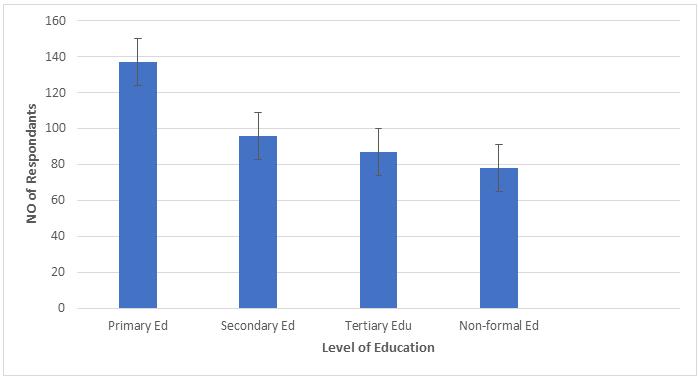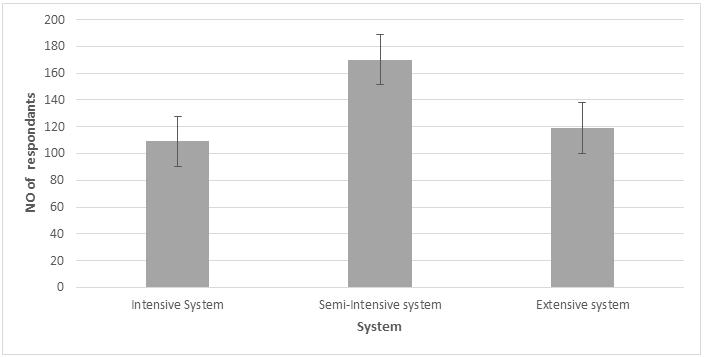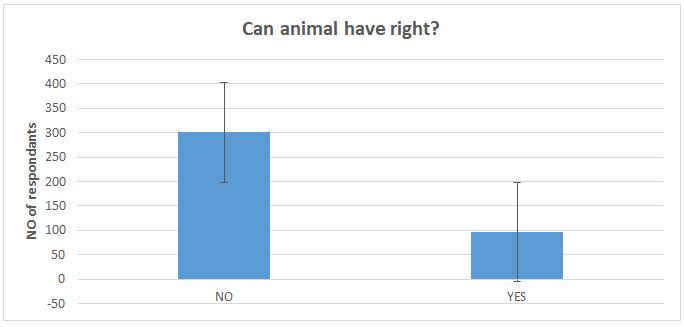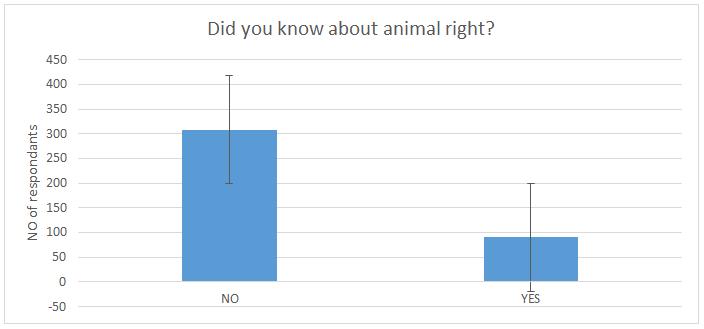ISSN 2348-313X (Print)
International Journal of Life Sciences Research ISSN 2348-3148 (online)
Vol. 8, Issue 2, pp: (24-28), Month: April - June 2020, Available at: www.researchpublish.com

ISSN 2348-313X (Print)
International Journal of Life Sciences Research ISSN 2348-3148 (online)
Vol. 8, Issue 2, pp: (24-28), Month: April - June 2020, Available at: www.researchpublish.com
Department of animal health and production technology, Federal Polytechnic Bali Taraba State Nigeria.
Abstract: Due to increasingly public abuse towards animals, there is need to investigate the perceptions of animal owners on animal rights. This work was to investigate people perceptions on animal rights which may also affects the welfare of the animals. Four hundreds (400) questionnaire eliciting vital information on system of rearing animals, educational background and people perceptions on animal right and welfare were distributed to animal owners in Bali local government area. Data were collected, analyzed and presented in a chart and simple percentage format for easy interpretation. The findings from these research shows that 308 (77.39%) of the respondents knows nothing about animal right while on 90 (22.61%) knows about animal rights. 301(75.63%) suggested that animals should not have rights while 97(24.37%) suggested that animal should have right. This could be attributed to the level of education and socioeconomic background of the farms.it is therefore recommend that serious awareness campaign should be adopted to enlighten livestock owners on animal rights and welfare.
Keywords: Animal, right, perceptions, people, abuse, cruelty, welfare
Animal cruelty is a human infliction of pains upon non-human animals for different reasons. Therefore, caging animals for laboratory testing and other purpose across the world violates the animal rights (Ankem, 2017). Animal cruelty has been a major issue of concern all over the world. It can be either deliberate violating the right of the animals or simply the failure to take care of animal; either way can cause pain to the animal (Ankem, 2017). So many people own animals and cannot meet up of their need, however, this is also counts as animal cruelty or abuse (Singer 1976). According to the human society of the United State, people with emotional problems like to hurt animals (Regan, 2004). However, this can be very dangerous because who can shoot, hit or set animals on fire, can also hurt other humans beings too (Singer 1976). One of the worst animal abuses is that when people leave their pet in cage they forget to feed them. (Deviney et al; 1983). Therefore the U.S State has their own law against animal cruelty because farmers and researchers can do cruel things to animal that other people cannot do legally. In order to better understanding, animal abuse in the United State. (Ascione; 2001)
Animal right belief that non-human animals have right to be free of human use and other abuse. There is also a confusion about animal right, a lot of people think that animal right means putting animals above humans (Regan, 2004). However, it is not possible because human and animal do not have the same morality. Almost everybody agreed with the facts that animals are absolutely not equal with humans. There are so many discussions about animal right, we have to think about the wild animals too when we cut down too many trees for words or we pollute the water and the air. According to Alice (1999), which states that animal have the right to live just as humans do. Animals have the same feelings and heartbeat. Non-human animals also express them self on different way to show some discomfort and pains (Joyce, 1979).
ISSN 2348-313X (Print)
International Journal of Life Sciences Research ISSN 2348-3148 (online) Vol. 8, Issue 2, pp: (24-28), Month: April - June 2020, Available at: www.researchpublish.com
There are different approaches to animal right philosophy, but all have certain common goal. This is obvious because all this stem from moral philosophies of right. This May seems too obvious to be worth or mentioning, but the fact is that there is a general misunderstanding and confusion regarding the difference between animal right and animal welfare. This misconception is common not only among the general public (Regan and Singer; 1989). Animal welfarist try to reduce pains inflicted on animals and improve their living standard to reduce physical and mental suffering. However, as suggested by others, animals are human property and of no moral value in and of themselves. (Singer, 1976) To humans, unnecessary killings of animal may prevent other human from aesthetically enjoying them. Animals have no claim on humans and they have no right, rather human have duties regarding animals, but not obligation to them. Animal right advocate view as possessing intrinsic value, the same rule applied to human right should be applied (Frey, 1978).
Animal right, view animal’s life as having an intrinsic value which supersede avoidance of unnecessary pain. therefore animals rights advocate suggested that certain right currently assigned to human beings (e.g the right to life) should be extended to non -human animal as well (council regulation (EC) №⅟2005). The issue of animal right is highly philosophical due to the fact that common sense is divided on it animal exist on boarder line of our moral concepts. Presently, animal are been seen as resources, livestock, pest, or obstacles (Herzog, 1990).The purpose of this study was to investigate people perception on animal right and welfare.
Bali is one of the local governments in Taraba state Nigeria. It has the population of 208,936(2006 census) and total area of 9146km². The local government lies roughly between latitude 6025N and 9°30N and between longitude 9030N and 11°45E and was created 1976. Bali local government is bounded by Gashaka local government in the east, Donga local government south west and Gassol local government north west. The main occupation is farming, fishing, hunting and rearing animals (source; Bali local government secretarial, 2019). Animal reared in the area are; cattle’s, sheep’s, goat, pig’s, and poultry . Crop produced on the other hand are; maize, rice, beans, groundnut, melon seeds, yam, soya beans which are cultivated in both subsistence and commercial level. Climate; annual mean temperature for Bali area is between 27°-28°c, 34° and 22°-24° respectively. The highest mean monthly temperature of about 34°c are recorded in April while lowest mean temperature of about 23°c are recorded in the month of January and December the annual rainfall range between 100-1200MM. rainfall is experienced for about seven month of the year starting from April to October, with mean monthly rainfall recording of about 220MM in the months of August and September (FPB metrological station 2019).
Four hundred (400) questionnaires were distributed to animal owners within Bali local government for the research work. 398 filled questionnaires were returned from the study area. The questionnaire contain participants demographic data, questions on public perception on animal right and welfare, rearing system. Before completing the questionnaires, participants were enlightened on the purpose of the study and were made to understand that completing the questionnaires are voluntary.
Data obtained for this research were presented in a chart for all the variables, the values were then presented in a simple percentage format for easy interpretation
Figure 1 shows the distribution of respondents based on level of education: Figure 1 shows that majority of the respondents 137(34.43%) attended primary education as their highest educational qualification, while 96(24.12%) went to secondary school as second majority, 87(21.86%) went to tertiary institution, and 78(19.60%) are non-formal educators.
ISSN 2348-313X (Print)
International Journal of Life Sciences Research ISSN 2348-3148 (online) Vol. 8, Issue 2, pp: (24-28), Month: April - June 2020, Available at: www.researchpublish.com

Figure 2 shows the distribution of respondents based on system of management: Majority of the Respondents 170(42.71%) practice semi-intensive management of rearing, while 119(29.90%) practice extensive system, and 109(27.39%) practice intensive. Therefore majority of farmers in the study area allow their animals to scavenge on their own and then supplement their feed in the evening in other to give them balance diet.

Figure 3 shows the distribution of respondents based on people perception on animal right: Vast majority of the respondents 308(77.39%) said (No) i.e they don’t know about animal right and minority of the respondents 90(22.61%) said (yes) they knows about animal right. This implies that the respondents in the selected areas have the following result. Mai-Hula; majority of the respondents (90%) said no and minority (10%) said yes, and Bali majority of the respondents (80%) said no and minority (20%) said yes, in Pangri, majority of respondents (70%) said no and minority (28%) said yes. In Sabon Dale, majority of respondents (68%) said no while minority (32%) said yes. Therefore majority of people in the study area don’t know about animal rights.
ISSN 2348-313X (Print)
International Journal of Life Sciences Research ISSN 2348-3148 (online) Vol. 8, Issue 2, pp: (24-28), Month: April - June 2020, Available at: www.researchpublish.com
From the data collected 301(75.63%) of the respondents said No. i.e animals should not have right, while 97(24.37%) of the respondents said Yes, meaning animal should have right. This implies that the following result was obtain from the selected areas; therefore only few respondents in the study area suggested that animals should have right.


Animal rights are the idea in which some or all non-human animals are entitled to the possession of their own existence and their own existence to freedom of been humiliated by human beings. Animal right are the belief that animals have right to be free of human use and exploitation, the issue of animal right is deeply philosophical due to the fact that common sense thinking is divided on it animal exist on borderline of our moral concept, this work is to examine people perception on animal rights and welfare. Using questionnaire as developed by Herzog et al (1991). The percentage of farmers who participate in this study were 99% which disagree with the percentage obtained from the study of Federical et al (2019)From the result obtained in figure 3, 308 (77.39%) respondents don’t know about animal rights and only (22.61%) respondents know about animal rights which agrees with result of (Alexia and Vincent 2017). Similarly, majority of the respondent 301(75.63%) suggested that animal should not have any right, while 97(24.37%) suggested that animal should have right. This could be attributed to the level of education of the respondents as majority of the respondents 137(34.43%) in the study area have primary education as their highest qualification. This is in conflict with the work of Kendal (2006) with shows that people from rural background accept animal use than the educated.
ISSN 2348-313X (Print)
International Journal of Life Sciences Research ISSN 2348-3148 (online) Vol. 8, Issue 2, pp: (24-28), Month: April - June 2020, Available at: www.researchpublish.com
Over the last decades, there have been several concerns and debates by scientist and lay men on animal right. Most research on people perceptions only centered only on laboratory animals. Based on the result obtained in this research work, it is concluded that majority of people in the study area don’t know about animal right and see no reasons why animals should have right. Therefore animal charity organization, animal welfarist and government should work hand in hand to advocates for animal rights. Similarly, knowledge of animal right should be included in the curriculum of primary and secondary level of education to enable student know about animal right since from their early stage of education; as lack of awareness on animal right could be attributed to their level of education as shown from this study.
[1] Austin, E.J., Deary I. Edward J. G., & Arey. D., (2005). Attitude to farm animal Welfare.
[2] Bentham J., 1989. An introduction to the principles of morals and legislation. London:
[3] Dawkins M.S., Chapman and hall. 1980. Animal suffering: the science of animal welfare. London, UK.
[4] Duncan I.J.H., 1981. Animal rights – animal welfare, a scientist assessment. Poults sci. vol 60: 489-499.
[5] Federica, P., Chlara, M., Angelo, G., Mariangela A., Claudio, S., and Silvana D., 2019. Attitudes towards animal and their welfare among Italian students. Journal of vet sci
[6] Gatward ,G.J., 2001. Livestock ethics Chalcombe publications; Lincoln, UK.
[7] Godfray, H.C.J., & Garnett. T., (2014). Food security and sustainable intensification.
[8] Harper, G., & Henson, S. (2001) consumer concerns about animal welfare and the Impact on food choice.
[9] Herzog, H.A.Jr. (1990). Philosophy, ethologic, and animal ethics. Trends 6, 14-17.
[10] Kendal H.A., Lobao L.M., Sharp J. 2006. Puplic concern on animal wellbeing; some international Comparison. Rural socio journal p 399-422
[11] Kyokai, B.D. 1987.The teaching of Buddha Tokyo, Kosaido. In Ryder RD, editor. Animal
[12] Linzey A. 1987. Christianity and the rights of animals. London SPCK.
[13] National research council .2011. The guide for the care and use of laboratory Animals (8th ed.) the national academics press, Washington, D.C.
[14] Narendra B. Ankem. 2017. Use of animals in biomedical research. Journal of clinical research and Bioethics. Vol 8 p 74. Ireland.
[15] Peter singer. 1976. Animal Libration. Article on Animal right.
[16] Regan, T.A. 1983. Case for animal’s rights. University of California press; Berkeley, USA.
[17] Revolution: 1966-1989. Changing Attitude towards specialism. Cambridge Basil back well; Massachusetts, USA
[18] Singer P. 1975.Animal liberation: a new ethics for our treatment of animals. New York Review/random house; New York, USA.
[19] Regan, T. 2004. Empty cages; Facing the challenges of animal right. (Newyork;Rowman and Littlefied) p 50.
[20] World organization for animal health. 2013. International standards, retrieved October 11, 2013, from http.//www.wholefoodsmarket.com/mission-value/animal-Welfare.
[21] World organization for animal health (OIE) .2009. Guidelines on stray dog Population control. OIE terrestrial animal health standards commission, annex.